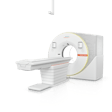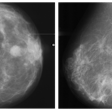CHICAGO - Coronary artery calcium (CAC) score CT can incidentally identify early-stage lung cancers, according to research presented on December 4 at the RSNA meeting.
"Our study underscores the importance of incidental lung nodule observation, reporting, and follow-up in calcium score exams for early lung cancer detection and treatment," presenter Syed Muhammad Awais Bukhari, MD, of Cleveland Medical Center told session attendees.
Calcium score screening (CSS) CT is known to be an effective way to assess cardiovascular disease risk and to guide therapy, Bukhari said. The fact that cardiovascular disease and lung cancer share several risk factors (such as smoking, obesity, and diabetes) means that lung cancers may be able to be detected in patients undergoing coronary artery calcium (CAC) score CT exams, Bukhari noted.
"Early detection [of lung cancer] is crucial, as survival rates are significantly higher for [disease] diagnosed at stage 1 or 2," he said.
He and colleagues investigated the prevalence of incidental lung cancer identified on routine calcium score screening ordered for cardiac assessment and evaluated the stage of diagnosis of any found lung cancers. They performed a study that included data from 914 patients who underwent CAC CT imaging between January 2013 and February 2019 and were diagnosed with lung cancer. Of the patient cohort, the majority were white (84.7%), female (66.8%), and former smokers (48%); 74.1% had hypertension, 24.8% had type 2 diabetes, and 32.1% had coronary artery disease.
Of these 914 patients, 216 were found to have a suspicious lung nodule or mass that was first detected on calcium score screening CT imaging. Of the 216 patients, 202 had primary lung cancer and 14 had secondary cancer. Among the primary lung cancer patients, 59.4% were diagnosed at stage 1 or earlier, Bukhari reported.
"[Our] study findings reveal that coronary artery calcium score CT can identify a substantial number of lung cancers at an early stage, [which offers] patients a significant opportunity for complete cure," he concluded.
In a talk delivered in the same session that also underscored the benefits of opportunistic CT imaging, Tong Yu, MD, of the University of Pittsburgh, shared findings from a study that indicated that body composition assessment on CT imaging shows promise for distinguishing between malignant and benign lung nodules.
The research included 216 individuals who participated in a low-dose CT lung cancer screening program; all had indeterminate pulmonary nodules (IPNs) identified on baseline CT imaging and at least one follow-up CT exam. Yu and colleagues used AI algorithms to segment and quantify IPNs and to track five body composition measures found on these baseline and follow-up exams.
In particular, they found that skeletal muscle density showed predictive power for distinguishing between malignant and benign lung nodules, with an area under the receiver operating curve of 0.87.
"Integrating body composition with nodule features can significantly improve the assessment of an IPN's malignancy," Yu concluded.
For full 2024 RSNA coverage, visit our RADCast.



















